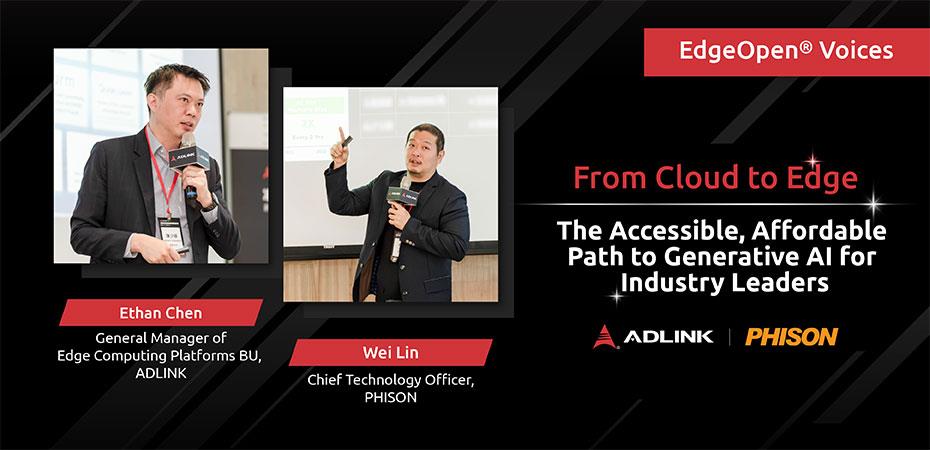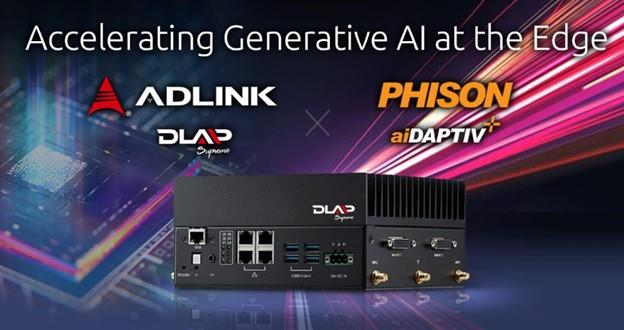-
제품
컴퓨터 온 모듈 GPU 솔루션 러기드 컴퓨팅 에지 컴퓨팅 플랫폼 산업용 디스플레이 시스템 및 패널 PC 네트워킹 & 서버 자동화 & 제어 설계 & 제조 서비스 헬스케어 컴퓨팅 & 모니터 게임 플랫폼 & 모니터 소프트웨어 -
솔루션
국방 및 우주 항공
국방 및 우주 항공 분야에서는 정확한 환경 관찰, 빠르고 신뢰할 수 있는 결정 및 시기적절한 조치가 매우 중요합니다. 에이디링크 테크놀로지의 견고한 시스템과 Data Distribution Service(DDS)는 대규모 데이터 인프라의 핵심적 부분으로, 데이터를 수집, 저장, 분석하고, 데이터를 현장에서 의사 결정자에게 전달합니다.
자세한 내용게임

에이디링크는 글로벌 게이밍 머신 생산업체에 하드웨어, 소프트웨어, 디스플레이를 제공하고 있습니다. 컴퓨터 전문 지식과 엣지 소프트웨어 스택의 결합, 그리고 게이밍 산업의 요구사항과 규제사항에 대한 깊은 이해를 바탕으로, 우리는 고객이 세계 최고의 게임을 제작하는데 집중할 수 있도록 지원합니다.
자세한 내용헬스케어

의료장비의 시각화 및 의료 인증을 받은 솔루션에 전념하고 있는 에이디링크 테크놀로지는 스마트 헬스케어의 디지털화 요구를 충족합니다. PENTA의 의료 분야 설계와 제조 능력을 기반으로 하는 에이디링크 테크놀로지의 헬스케어 솔루션은, 다양한 의료 환경 속에서 디지털 어플리케이션의 적용이 가능하도록 합니다.
자세한 내용반도체 솔루션

모든 것은 기본적으로 칩에 의해 구동되며, 다양한 애플리케이션의 요구에 맞게, 품질과 효율성과 생산성에 이르기까지 모든 것을 보장하는 완벽한 웨이퍼 제조 프로세스가 필요합니다.
자세한 내용스마트 팩토리

엣지 컴퓨팅을 기반으로 하는 에이디링크 스마트 제조 솔루션은 의사 결정을 위해 더 빠른 데이터를 보장하고, 반도체 및 전자 제조를 위한 보다 탄력적이고 안전한 생산 환경을 조성합니다.
자세한 내용철도

우리의 러기드한 CompactPCI,컴퓨터 온 모듈, 산업용 등급의 시스템과 패널 컴퓨터 제품 포트폴리오는 온보드 ATO/DMI와 철로 CTC/RBC/TSR 레일웨이 솔루션에서 사용되고 있습니다. 에이디링크의 우수한 디자인 및 생산력은 전세계 유수한 철도 신호 공급업체에서 채택되고 있습니다.
자세한 내용로보틱스

AMR(자율이동로봇)은 사람 없이 혹은 최소의 사람의 감독만으로 임무를 수행할 수 있습니다. 학교, 병원, 쇼핑몰, 공장과 같은 시설에서는 스웜 AMR 을 적용하여 운영 효율성과 삶의 질을 향상시킬 수 있습니다.
자세한 내용 -
전략 파트너
AMD 기반 솔루션
엣지 컴퓨팅을 선도하는 에이디링크와 함께 귀사의 엣지 전략을 강화하세요. AMD의 고성능, 보안 통합 및 전력 효율성의 장점을 활용하여 x86 코어 아키텍처 기반의 다양한 엣지 및 네트워킹 시스템을 구현할 수 있습니다. Radeon™ RX가 탑재된 AMD Ryzen™ Embedded 시리즈를 통해 향상된 연산 및 그래픽 성능을 경험해보세요. 산업, 의료, 자동화 및 게임 애플리케이션에 이상적입니다.
자세한 내용Ampere 기반 솔루션
Ampere Altra 기반의 COM-HPC 모듈, 개발 플랫폼 및 개발 키트를 포함한 에이디링크의 종합적인 제품군으로 엣지 컴퓨팅의 미래를 경험하세요. 산업 자동화, 자율 주행, 운송, 헬스케어, 영상 감시, 에너지 관리 등 다양한 애플리케이션에 대해 탁월한 성능, 에너지 효율성, 최적의 TCO를 실현합니다.
자세한 내용Arm 기반 솔루션
Arm 아키텍처를 기반으로, 에이디링크는 Ampere, NXP, MediaTek, Qualcomm, Rockchip과 협업하여 스마트 제조, 자율 주행, 로보틱스, AMR, 드론, 운송, 물류, 리테일, 인포테인먼트, 헬스케어, 보안 등 다양한 산업에 모듈 컴퓨팅 및 부가가치 솔루션을 제공합니다.
플러그 앤 플레이 도구, 개발 키트 및 통합 시스템을 통해 에이디링크와 Arm은 개발자들이 혁신을 가속화하고 실현할 수 있도록 지원합니다.
자세한 내용Intel 기반 솔루션
에이디링크는 인텔 프레스티지 파트너입니다, 모듈형 컴퓨팅부터 시스템 레벨의 실제 적용 사례까지 Intel과 긴밀히 협력하고 있습니다. 확장 가능하고 상호 운용 가능한 솔루션을 통해 지능형 디바이스의 배포를 가속화하며, 엔드-투-엔드 분석도 제공합니다.
Intel 기반 모듈을 활용하여 에이디링크는 엣지 AI 플랫폼 개발을 제공하며, 네트워킹, 스마트 제조, 자율 주행, AMR, 운송, 의료, 리테일 및 인포테인먼트 등 다양한 산업의 문제를 해결합니다.
자세한 내용MediaTek 기반 솔루션
에이디링크 테크놀로지와 MediaTek은 전략적 파트너로서 엣지 컴퓨팅 및 엣지 AI 애플리케이션을 위한 혁신적이고 강력한 솔루션을 제공합니다. MediaTek의 고효율 Genio 플랫폼 SoC와 에이디링크의 임베디드 및 러기드 설계 전문성을 결합하여 스마트 홈, 휴먼-머신 인터페이스, 멀티미디어, 산업용 IoT, 로보틱스 등 다양한 IoT 활용 사례를 위한 고성능, 에너지 효율적이며 신뢰성 높은 모듈 및 플랫폼을 제공합니다.
자세한 내용NVIDIA 기반 솔루션
산업별 요구사항을 충족하기 위해 에이디링크는 NVIDIA Jetson 모듈, NVIDIA IGX 플랫폼, RTX 임베디드 GPU를 기반으로 엣지 AI 플랫폼, AI 스마트 카메라, 의료 플랫폼, AI GPU 가속기 등을 효율적으로 개발합니다. 스마트 제조, 자율 주행, AMR, 로보틱스, 운송, 헬스케어, 물류, 리테일, 인포테인먼트, AI 개발, 전문가용 그래픽, 게임 등 다양한 산업에 적합합니다.
자세한 내용NXP 기반 솔루션
에이디링크는 NXP의 i.MX 8 및 i.MX 9 시리즈 기술을 활용하여 의료, 테스트 및 측정, 자동화, 스마트 시티 고객이 총소유비용(TCO)을 절감할 수 있도록 엣지 연결 솔루션을 제공합니다. NXP 기술과 에이디링크의 엣지 컴퓨팅 R&D 경험이 결합되어 핵심 애플리케이션에 대한 유연하고 역동적인 솔루션을 구현합니다.
자세한 내용Qualcomm 기반 솔루션
Qualcomm Technologies는 로보틱스 및 드론 분야의 선도적인 솔루션 포트폴리오를 통해 자율 배송, 미션 크리티컬 애플리케이션, 상업 및 기업용 드론 등 차세대 활용 사례를 이끌고 있습니다.
그 중 Qualcomm QRB5165 솔루션은 5G 연결, 온디바이스 AI 및 머신 러닝, 고성능 컴퓨팅, 지능형 센싱 기능을 갖춘 소비자, 기업 및 산업용 로봇 개발을 지원합니다. 에이디링크는 QRB5165를 채택하여 로보틱스 및 지능형 시스템에서 5G 확산을 가속화합니다.
자세한 내용
-
고객지원
-
회사 소개
한국어
English
繁體中文
简体中文
日本語
- 로그인
- home
- 제품
-
솔루션
국방 및 우주 항공
국방 및 우주 항공 분야에서는 정확한 환경 관찰, 빠르고 신뢰할 수 있는 결정 및 시기적절한 조치가 매우 중요합니다. 에이디링크 테크놀로지의 견고한 시스템과 Data Distribution Service(DDS)는 대규모 데이터 인프라의 핵심적 부분으로, 데이터를 수집, 저장, 분석하고, 데이터를 현장에서 의사 결정자에게 전달합니다.
자세한 내용게임

에이디링크는 글로벌 게이밍 머신 생산업체에 하드웨어, 소프트웨어, 디스플레이를 제공하고 있습니다. 컴퓨터 전문 지식과 엣지 소프트웨어 스택의 결합, 그리고 게이밍 산업의 요구사항과 규제사항에 대한 깊은 이해를 바탕으로, 우리는 고객이 세계 최고의 게임을 제작하는데 집중할 수 있도록 지원합니다.
자세한 내용헬스케어

의료장비의 시각화 및 의료 인증을 받은 솔루션에 전념하고 있는 에이디링크 테크놀로지는 스마트 헬스케어의 디지털화 요구를 충족합니다. PENTA의 의료 분야 설계와 제조 능력을 기반으로 하는 에이디링크 테크놀로지의 헬스케어 솔루션은, 다양한 의료 환경 속에서 디지털 어플리케이션의 적용이 가능하도록 합니다.
자세한 내용반도체 솔루션

모든 것은 기본적으로 칩에 의해 구동되며, 다양한 애플리케이션의 요구에 맞게, 품질과 효율성과 생산성에 이르기까지 모든 것을 보장하는 완벽한 웨이퍼 제조 프로세스가 필요합니다.
자세한 내용스마트 팩토리

엣지 컴퓨팅을 기반으로 하는 에이디링크 스마트 제조 솔루션은 의사 결정을 위해 더 빠른 데이터를 보장하고, 반도체 및 전자 제조를 위한 보다 탄력적이고 안전한 생산 환경을 조성합니다.
자세한 내용철도

우리의 러기드한 CompactPCI,컴퓨터 온 모듈, 산업용 등급의 시스템과 패널 컴퓨터 제품 포트폴리오는 온보드 ATO/DMI와 철로 CTC/RBC/TSR 레일웨이 솔루션에서 사용되고 있습니다. 에이디링크의 우수한 디자인 및 생산력은 전세계 유수한 철도 신호 공급업체에서 채택되고 있습니다.
자세한 내용로보틱스

AMR(자율이동로봇)은 사람 없이 혹은 최소의 사람의 감독만으로 임무를 수행할 수 있습니다. 학교, 병원, 쇼핑몰, 공장과 같은 시설에서는 스웜 AMR 을 적용하여 운영 효율성과 삶의 질을 향상시킬 수 있습니다.
자세한 내용 -
전략 파트너
AMD 기반 솔루션
엣지 컴퓨팅을 선도하는 에이디링크와 함께 귀사의 엣지 전략을 강화하세요. AMD의 고성능, 보안 통합 및 전력 효율성의 장점을 활용하여 x86 코어 아키텍처 기반의 다양한 엣지 및 네트워킹 시스템을 구현할 수 있습니다. Radeon™ RX가 탑재된 AMD Ryzen™ Embedded 시리즈를 통해 향상된 연산 및 그래픽 성능을 경험해보세요. 산업, 의료, 자동화 및 게임 애플리케이션에 이상적입니다.
자세한 내용Ampere 기반 솔루션
Ampere Altra 기반의 COM-HPC 모듈, 개발 플랫폼 및 개발 키트를 포함한 에이디링크의 종합적인 제품군으로 엣지 컴퓨팅의 미래를 경험하세요. 산업 자동화, 자율 주행, 운송, 헬스케어, 영상 감시, 에너지 관리 등 다양한 애플리케이션에 대해 탁월한 성능, 에너지 효율성, 최적의 TCO를 실현합니다.
자세한 내용Arm 기반 솔루션
Arm 아키텍처를 기반으로, 에이디링크는 Ampere, NXP, MediaTek, Qualcomm, Rockchip과 협업하여 스마트 제조, 자율 주행, 로보틱스, AMR, 드론, 운송, 물류, 리테일, 인포테인먼트, 헬스케어, 보안 등 다양한 산업에 모듈 컴퓨팅 및 부가가치 솔루션을 제공합니다.
플러그 앤 플레이 도구, 개발 키트 및 통합 시스템을 통해 에이디링크와 Arm은 개발자들이 혁신을 가속화하고 실현할 수 있도록 지원합니다.
자세한 내용Intel 기반 솔루션
에이디링크는 인텔 프레스티지 파트너입니다, 모듈형 컴퓨팅부터 시스템 레벨의 실제 적용 사례까지 Intel과 긴밀히 협력하고 있습니다. 확장 가능하고 상호 운용 가능한 솔루션을 통해 지능형 디바이스의 배포를 가속화하며, 엔드-투-엔드 분석도 제공합니다.
Intel 기반 모듈을 활용하여 에이디링크는 엣지 AI 플랫폼 개발을 제공하며, 네트워킹, 스마트 제조, 자율 주행, AMR, 운송, 의료, 리테일 및 인포테인먼트 등 다양한 산업의 문제를 해결합니다.
자세한 내용MediaTek 기반 솔루션
에이디링크 테크놀로지와 MediaTek은 전략적 파트너로서 엣지 컴퓨팅 및 엣지 AI 애플리케이션을 위한 혁신적이고 강력한 솔루션을 제공합니다. MediaTek의 고효율 Genio 플랫폼 SoC와 에이디링크의 임베디드 및 러기드 설계 전문성을 결합하여 스마트 홈, 휴먼-머신 인터페이스, 멀티미디어, 산업용 IoT, 로보틱스 등 다양한 IoT 활용 사례를 위한 고성능, 에너지 효율적이며 신뢰성 높은 모듈 및 플랫폼을 제공합니다.
자세한 내용NVIDIA 기반 솔루션
산업별 요구사항을 충족하기 위해 에이디링크는 NVIDIA Jetson 모듈, NVIDIA IGX 플랫폼, RTX 임베디드 GPU를 기반으로 엣지 AI 플랫폼, AI 스마트 카메라, 의료 플랫폼, AI GPU 가속기 등을 효율적으로 개발합니다. 스마트 제조, 자율 주행, AMR, 로보틱스, 운송, 헬스케어, 물류, 리테일, 인포테인먼트, AI 개발, 전문가용 그래픽, 게임 등 다양한 산업에 적합합니다.
자세한 내용NXP 기반 솔루션
에이디링크는 NXP의 i.MX 8 및 i.MX 9 시리즈 기술을 활용하여 의료, 테스트 및 측정, 자동화, 스마트 시티 고객이 총소유비용(TCO)을 절감할 수 있도록 엣지 연결 솔루션을 제공합니다. NXP 기술과 에이디링크의 엣지 컴퓨팅 R&D 경험이 결합되어 핵심 애플리케이션에 대한 유연하고 역동적인 솔루션을 구현합니다.
자세한 내용Qualcomm 기반 솔루션
Qualcomm Technologies는 로보틱스 및 드론 분야의 선도적인 솔루션 포트폴리오를 통해 자율 배송, 미션 크리티컬 애플리케이션, 상업 및 기업용 드론 등 차세대 활용 사례를 이끌고 있습니다.
그 중 Qualcomm QRB5165 솔루션은 5G 연결, 온디바이스 AI 및 머신 러닝, 고성능 컴퓨팅, 지능형 센싱 기능을 갖춘 소비자, 기업 및 산업용 로봇 개발을 지원합니다. 에이디링크는 QRB5165를 채택하여 로보틱스 및 지능형 시스템에서 5G 확산을 가속화합니다.
자세한 내용
-
고객지원
-
회사 소개





_18062207264872140.png)




